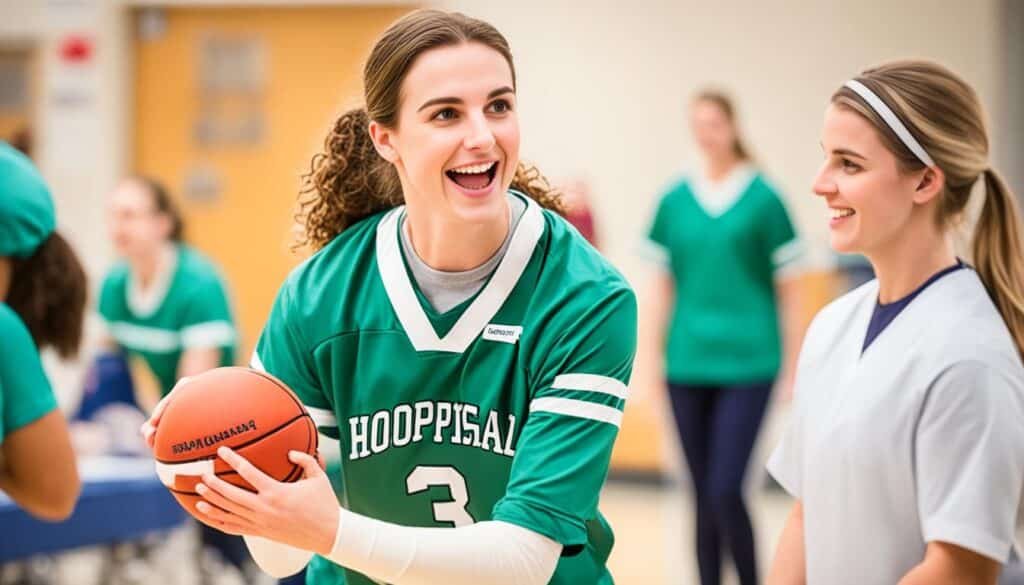Getting into a highly ranked medical college in the United States is incredibly tough. The numbers show that only 5.5% of applicants were accepted on average. For the most prestigious colleges of medicine, like Stanford or Harvard, acceptance rates were even lower.
In particular, Stanford only accepted 1.4% of its applicants, and Harvard just 2.8%. That makes it clear how competitive it is to get in.
Doing well in your studies is crucial, but it’s just a start. Prospective medical students should show they really love medicine and care deeply about patients. They should also demonstrate the potential to be top-notch health science practitioners.
Key Takeaways
- The average acceptance rate for U.S. medical schools is only 5.5%, with elite schools taking fewer than 3%.
- Top grades and MCAT scores are key to getting into a premier college of medicine.
- Showing a true passion for medicine and patient care is important.
- It helps to gain experience through graduate medical and undergraduate medical education.
- Thinking about what each school values and adjusting your application can boost your chances.
Understanding the Admissions Landscape
Getting into a top medical school in the U.S. is tough. The average acceptance rate among 129 schools was only 5.5% in 2021-2022. This shows how many want to attend but there are few spots.
Closer inspection reveals that out of 55,188 applicants, only about 24,000 got in during 2022-2023. This makes the acceptance rate 43.1%. It’s clear that the process to become a medical student is highly competitive.
Prestigious Medical Schools with Lowest Acceptance Rates
Highly ranked medical schools like Stanford and Harvard have very low acceptance rates. Stanford only accepted 1.4% of applicants, while Harvard accepted 2.8% in 2021-2022. These numbers highlight the competition for spots in the best health science programs.
Building a Strong Academic Profile

To get into a top medical school in the U.S., it’s not just about grades and MCAT scores. Medical school applicants should aim for more. They need a balanced profile showing their love for medical sciences. And they should show they can be great healthcare professionals in the future.
Maintaining an Excellent GPA
A high grade point average (GPA) is key for getting into medical school. The top schools and university hospitals look for students with GPAs of 3.8 or more. Keeping a strong GPA shows your dedication to studying biomedical and health sciences. It also proves you can handle tough academic challenges.
Acing the MCAT
Along with good grades, doing well on the Medical College Admission Test (MCAT) is crucial. The MCAT tests your knowledge of basic sciences, critical thinking, and problem-solving. These skills are vital for your future medical education and training. Aim for a 90th percentile or higher on the MCAT. This boosts your chance of getting into the best medical schools in the U.S.
| Metric | Top Medical Schools Average | National Average |
|---|---|---|
| GPA | 3.9 | 3.7 |
| MCAT | 515 | 506 |
Crafting Compelling Recommendation Letters

Recommendation letters play a big part in the medical school application process. Ensure you don’t just ask a high-scoring professor for one. Medical school admissions committees won’t find those generic letters impressive.
Forming Meaningful Relationships with Mentors
It’s key to establish real, deep connections with mentors. They must know your medical student potential and your passion for the medical sciences. They should talk about your leadership, strengths, and dedication to patient care and academic medicine.
Providing Context for Letter Writers
When you ask for a recommendation letter, share your achievements and your story. Giving them these details helps in writing a strong, personal letter. This kind of letter can stand out to medical school admissions committees.
| Characteristic | Strong Recommendation Letter | Weak Recommendation Letter |
|---|---|---|
| Relationship with Applicant | Close, mentoring relationship | Casual acquaintance |
| Knowledge of Applicant | Detailed understanding of strengths, accomplishments, and potential | Superficial or generic knowledge |
| Letter Content | Specific examples, anecdotes, and insights that showcase applicant’s qualifications | Vague, impersonal, and lacking in substantive information |
| Overall Impression | Enthusiastic, persuasive, and memorable | Uninspired and unlikely to differentiate applicant |
Showcasing Relevant Extracurricular Activities

Academic success matters a lot for top medical schools. But, they also look closely at your extracurricular activities. This is because these activities show your diverse interests and skills for the medical field.
Depth Over Breadth
Experts suggest going deep instead of wide in extracurriculars. It’s better to deeply commit to a couple of things than spread yourself thin. Leading, starting new projects, or volunteering over time can make a big difference.
Highlighting Transferable Skills
When talking about your activities, focus on the skills you’ve gained. Think about skills like good communication, teamwork, and time management. These are super important for being a great healthcare provider.
This approach can help stand out when applying to medical school. It shows you’re ready for both the challenges and wins of a medical career.
Demonstrating Passion for Medical College
Future doctors need to show they love medicine when applying for medical school. They must have good grades and real-world experience in patient care. This proves their commitment to the medical field and its science.
Seeking Volunteering and Shadowing Opportunities
Top medical schools in the United States really look at how much an applicant has volunteered and shadowed. These activities give a glimpse into what being a medical student and doctor is like. It shows the patient-centered side of being in medicine.
Looking for places to volunteer, like at hospitals or community health centers, is key. It lets applicants see the healthcare system up close. They should also shadow doctors from different fields. This might include primary care, pediatrics, or family medicine. Such experiences improve their understanding of medicine in practice.
Actively finding these hands-on experiences shows how much they love the medical field. It makes them stand out to medical school admissions. This work can help them get into the medical school they dream of.
Also Read: Top Ranked Best Medical Schools In The USA
Applying Strategically to Top Medical Colleges
Getting into a top medical college is tough. So, it’s key to apply smartly. Knowing what each college values can improve your odds of getting in.
Considering Institutional Missions
Top medical colleges each have their own missions and focuses. For example, some excel in research, while others champion health care in local communities. It’s wise to look into what these institutions stand for. This way, you can choose schools that match your interests and goals as a medical student or medical degree holder.
Tailoring Applications to Each School
After picking the medical colleges you like, tailor your applications to them. Showcase how you fit their goals. Highlight activities, such as extracurricular activities and research projects, that show your dedication to medicine. Also, demonstrate how you share their values.
Knowing the unique aspects of each college is crucial. It lets you put your best foot forward. With this approach, you can increase your chances of standing out. This method could open the door to top medical universities or colleges of medicine. It’s the strategy that might lead to your dream of becoming a healthcare provider.
FAQs
Q: What are the key steps to getting into a top medical college in the US?
A: To get into a top medical college in the US, you should focus on maintaining a high GPA, scoring well on the MCAT exam, gaining relevant clinical experience, participating in extracurricular activities, securing strong letters of recommendation, and crafting a compelling personal statement.
Q: What are the different degree programs offered by top medical colleges in the US?
A: Top medical colleges in the US offer various degree programs such as Doctor of Medicine (MD), Doctor of Osteopathic Medicine (DO), and graduate programs in specialized medical fields.
Q: How can financial aid help in attending a top medical college?
A: Financial aid can play a crucial role in attending a top medical college by covering tuition costs, living expenses, and other educational fees, thus making it more affordable for students to pursue their medical education.
Q: What are some common medical specialties that students can pursue in top medical colleges?
A: Some common medical specialties that students can pursue in top medical colleges include cardiology, neurology, oncology, pediatrics, surgery, and many others, depending on their interests and career goals.
Q: How important is it for a top medical college to be recognized by the U.S.?
A: It is crucial for a top medical college to be recognized by the U.S. as it ensures that the institution meets certain standards of quality and excellence in medical education, making the degrees and training received there widely accepted and respected.
Q: What role do teaching hospitals play in the education of medical students?
A: Teaching hospitals play a vital role in the education of medical students by providing them with hands-on clinical experience, exposure to a variety of medical cases, and opportunities to work alongside experienced healthcare professionals.
Q: How do top medical colleges in the US contribute to global health initiatives?
A: Top medical colleges in the US contribute to global health initiatives by conducting research, offering international medical programs, participating in medical missions abroad, and training students to address healthcare disparities on a global scale.
